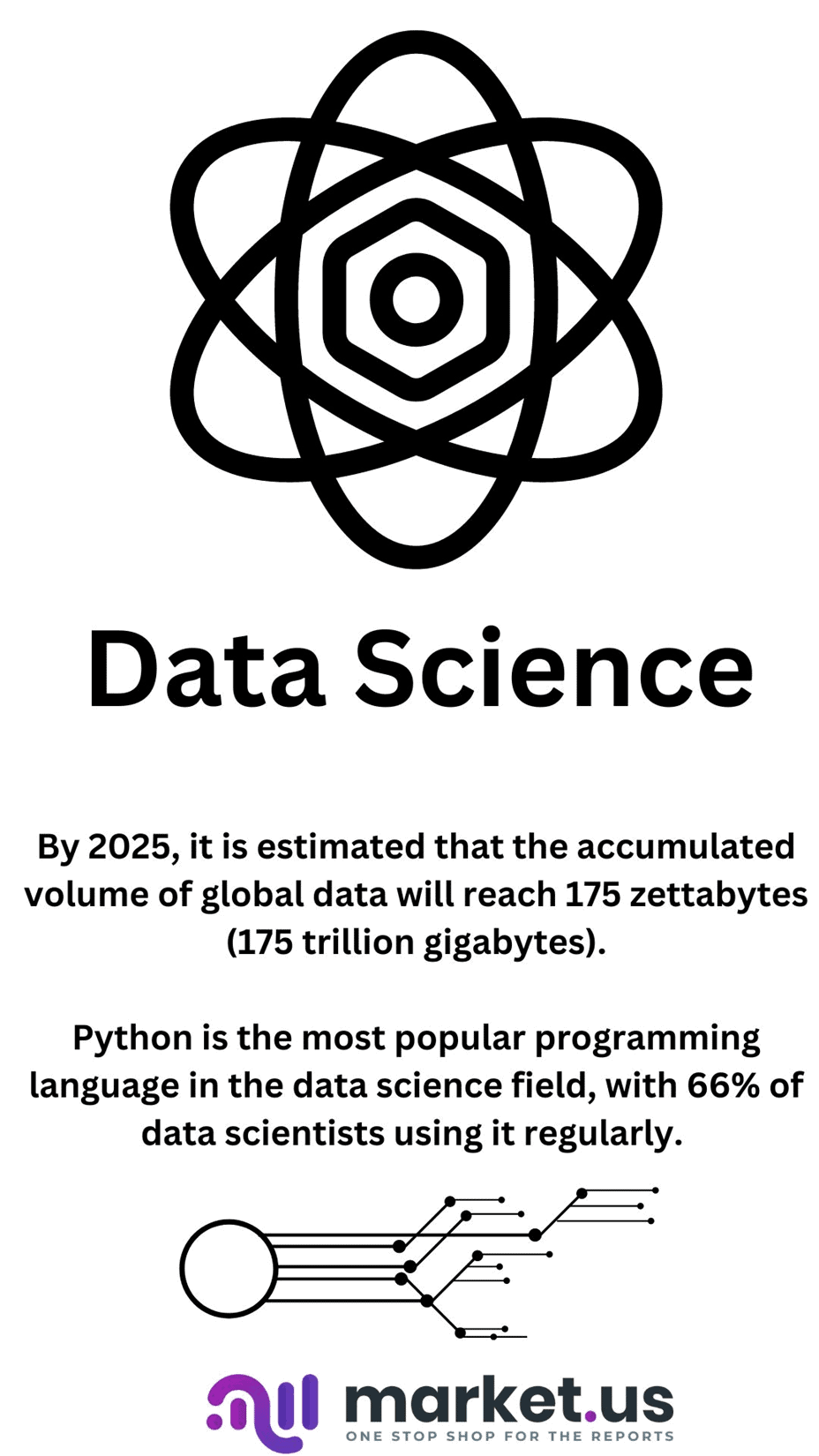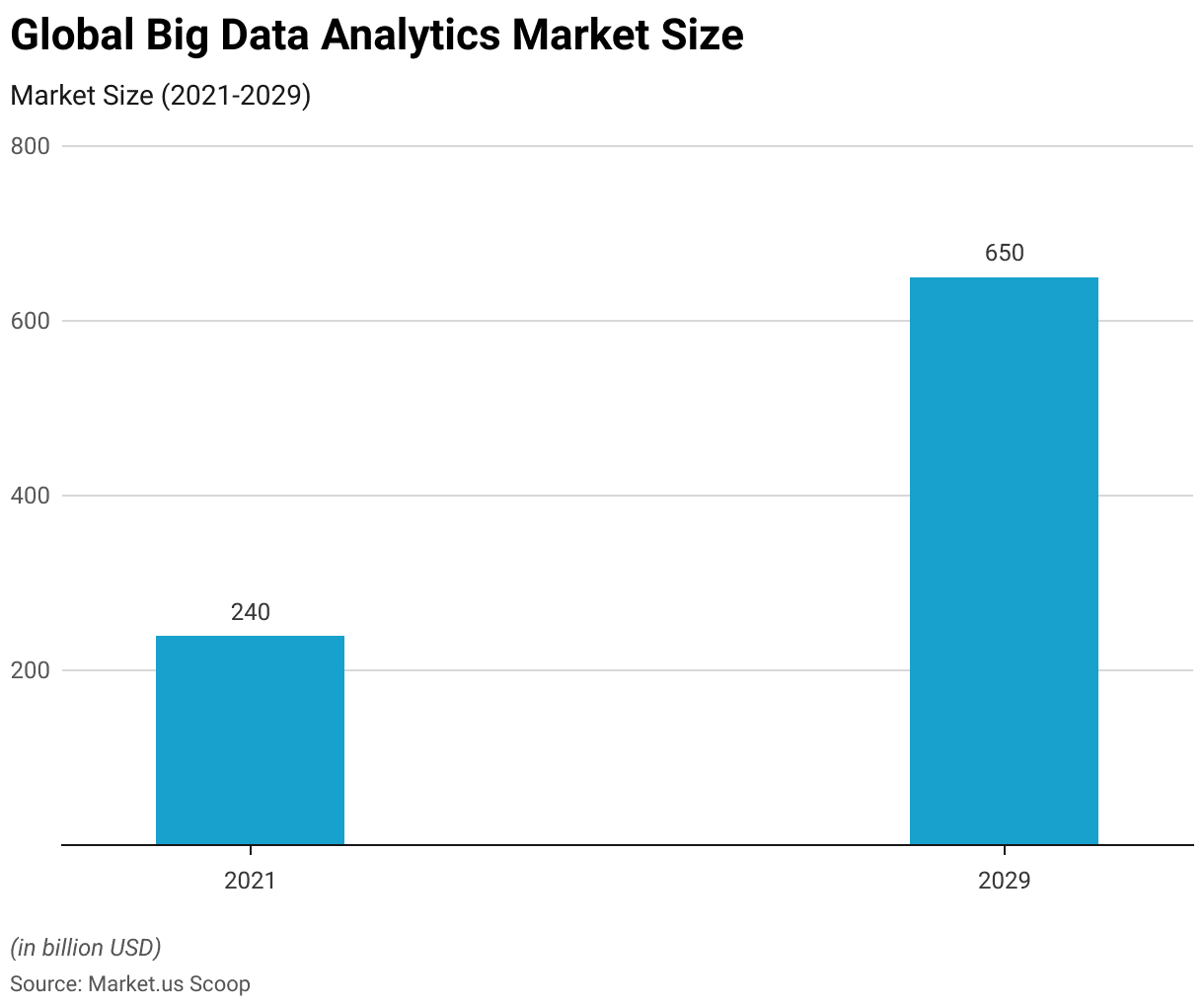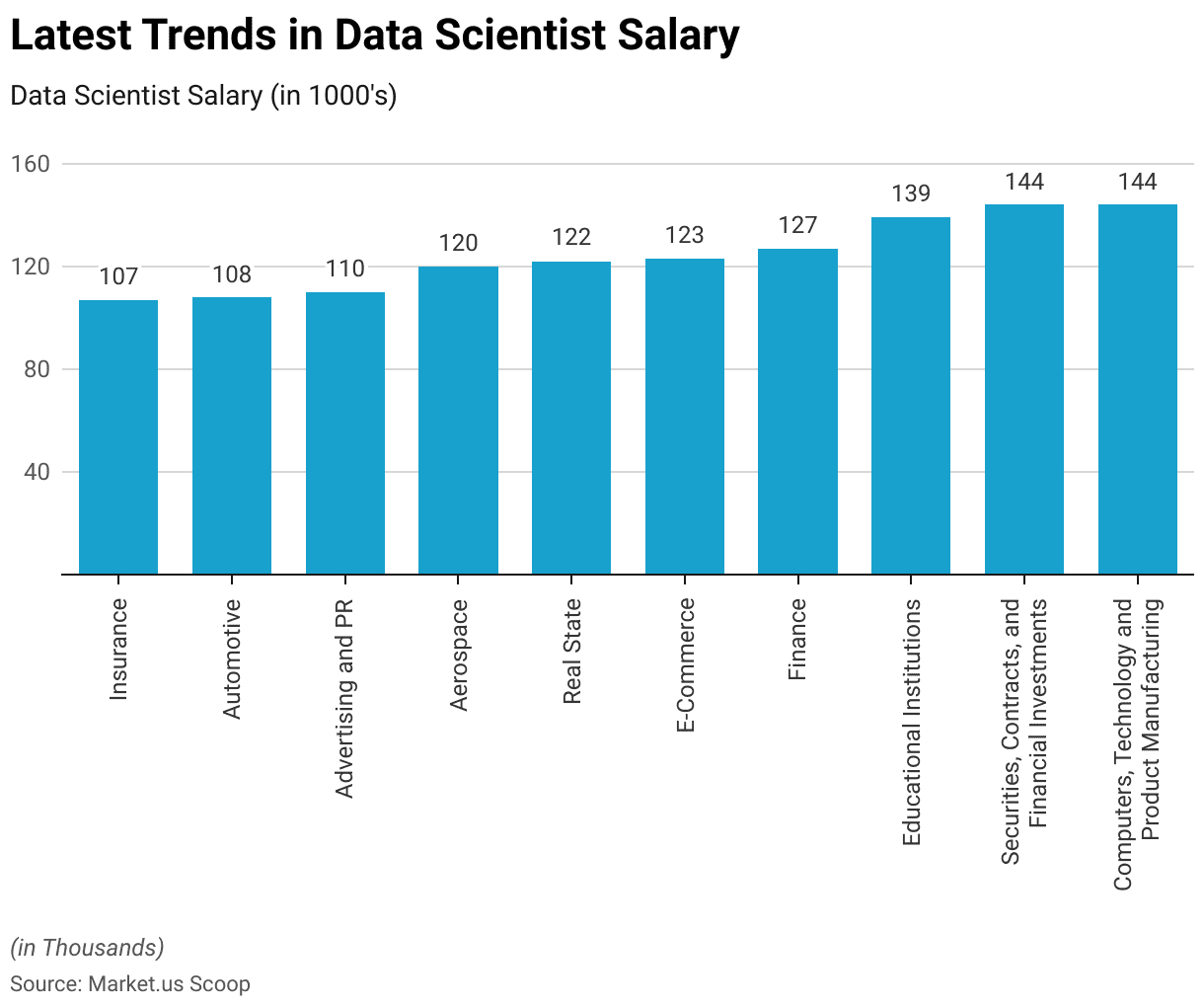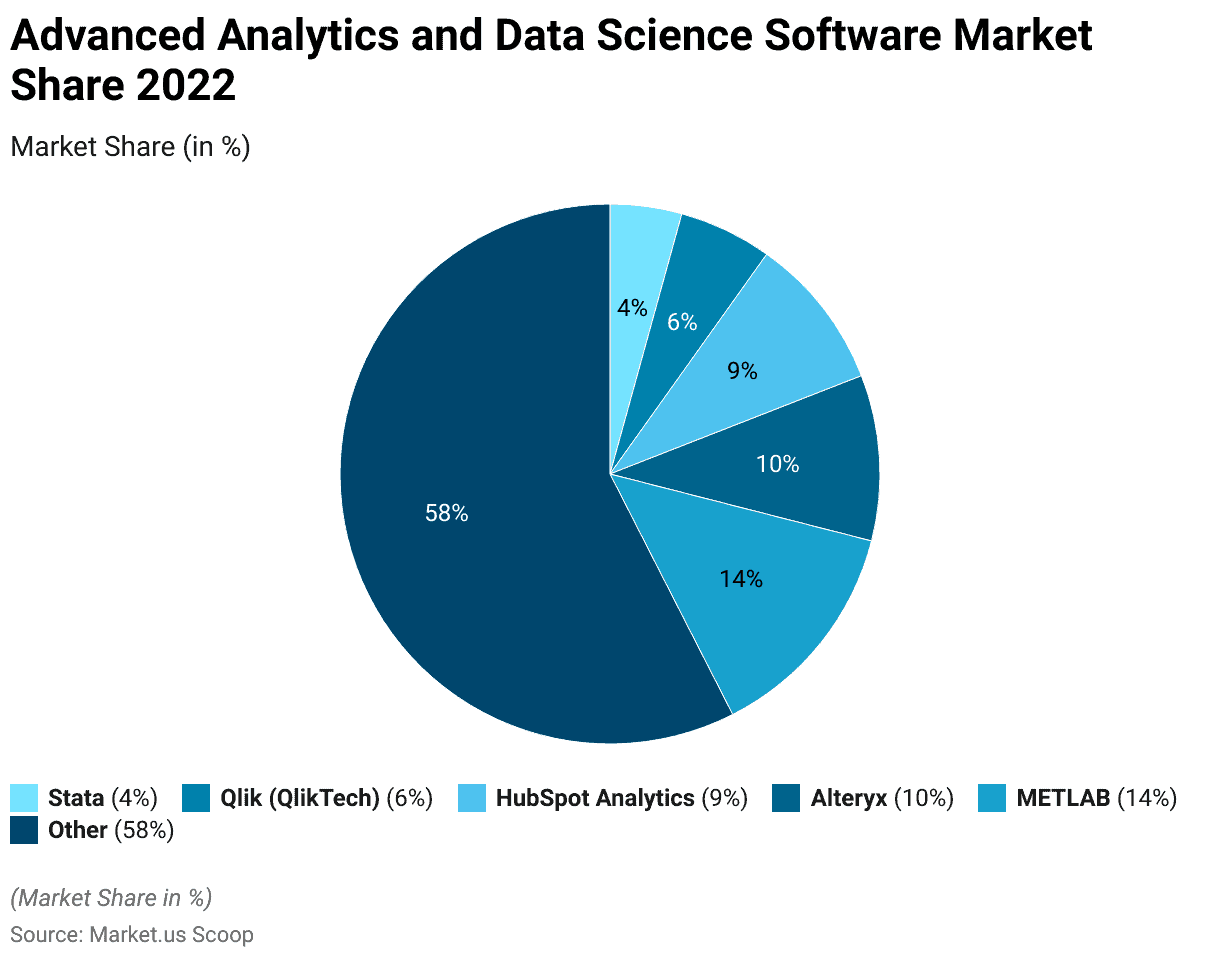Table of Contents
- Introduction
- Editor’s Choice
- What is data science?
- Data Science Statistics – Scope
- Data Science Statistics – The Power of Data Analytics
- Data Science Statistics – Roles of Data Scientists
- Data Science Statistics – Growth and Impact
- Data Science Statistics – In Industries
- Data Science Statistics – AI Implementation
- Data Science Statistics – Future Outlook
- Data Science Statistics – Challenges
- Recent Developments
- Key Takeaways
- FAQs
Introduction
Data Science Statistics: The main goal of data science is to uncover patterns, and make predictions. It derives meaningful insights from data to drive informed decision-making and solve complex problems.
It involves the collection, cleaning, processing, analysis, and interpretation. The large volumes of data to extract valuable information and gain actionable insights.

Editor’s Choice
- The Data Science Platform Market size is to be worth USD 1,826.9 Billion by 2033, from USD 145.4 Billion.
- Growing at a CAGR of 28.8% during the forecast period from 2024 to 2033.
- The global market for data science platforms was worth USD 64,099.12 million in 2021
- Expected to increase at a compound annual growth rate (CAGR) of 25.7% between 2022-2032.
- The demand for data scientists has increased by 56% from 2020 to 2022.
- The average annual salary of a data scientist in the United States is $122,840.
- 65% of organizations believe that data science is essential for decision-making.
- 90% of enterprises believe that data science is crucial for their business success.
- Python is the most popular programming language in the data science field, with 66% of data scientists using it regularly.
- Machine learning and deep learning skills are among the top skills sought by employers in the data science field.
- Only 26% of data professionals worldwide are women.
- 81% of data scientists are concerned about the potential ethical implications of their work.
- The amount of data created globally is expected to reach 175 zettabytes by 2025.
- 37% of organizations have implemented AI in some form, which is a 270% increase over the past four years.
(Source: Market.us, LinkedIn Workforce Report, U.S. Bureau of Labor Statistics, Forbes, NewVantage Partners, Kaggle, LinkedIn, Data Science Society, Anaconda, IDC)
What is data science?
Data science is an interdisciplinary field that combines various techniques. Various tools, and methodologies to extract insights from structured and unstructured data. It encompasses a wide range of disciplines, including statistics, mathematics, computer science, machine learning, and domain expertise. The total amount of data created, captured, copied, and consumed globally is forecast to increase rapidly. The data reached 64.2 zettabytes in 2020.

Data Science Statistics – Scope
- By 2025, it is estimated that the accumulated volume of global data will reach 175 zettabytes (175 trillion gigabytes).
- According to LinkedIn, data science-related job postings have grown by 256% since 2013.
- The average annual salary of a data scientist in the United States is $120,000. With top professionals earning over $200,000 per year.
- In a survey conducted by Kaggle, 83% of data scientists reported that they use machine learning methods regularly in their work.
- McKinsey Global Institute predicts that by 2026, demand for data scientists in the United States will exceed supply by over 50%.
- Data science and analytics jobs are among the fastest-growing job roles. With a projected growth rate of 15% by 2029, according to the U.S. Bureau of Labor Statistics.
- The healthcare sector is increasingly utilizing data science. With the global healthcare analytics market is expected to reach $84.2 billion by 2027.
- According to a report by IBM, 59% of organizations believe that adopting big data and analytics is a key factor in gaining a competitive advantage.
- Data-driven organizations are 23 times more likely to acquire customers and six times more likely to retain them.
(Source: IDC, LinkedIn, Indeed, Kaggle, McKinsey Global Institute, U.S. Bureau of Labor Statistics, IBM, McKinsey & Company)
Data Science Statistics – The Power of Data Analytics
Data science enables organizations to make informed decisions based on empirical evidence rather than relying on intuition or guesswork. By analyzing large datasets, identifying patterns, and extracting insights, data science helps businesses optimize operations. Develop effective strategies, and improve decision-making processes.
- According to the BCG-WEF project research, 72% of industrial businesses employ advanced data analytics to boost productivity.
- By 2025, the healthcare sector’s market for big data analytics might be worth US$ 67.82 billion.
- In 2022, 68% of international travel brands made major investments in business intelligence and predictive analytics capabilities, according to Statista Research Department.
- Managing unstructured data is a challenge for their industry, according to 95% of businesses.
- Around 47% of McKinsey study participants claimed that data analytics had altered the competitive landscape in their industry and that data science had given companies a competitive edge.
- WhatsApp users may exchange 65 billion messages every day.
- Netflix saves around US$ 1 billion yearly on user retention.
- The global big data analytics market accounted for revenue of USD 240 billion in 2021. The market is projected to reach a revenue of USD 650 billion by 2029.
(Source: Statista)
Take advantage of our unbeatable offer - buy now!


Data Science Statistics – Roles of Data Scientists
- Data scientists spend about 80% of their time on data preparation, cleaning, and integration tasks, also known as data wrangling.
- According to Glassdoor, data scientist was ranked as the best job in the United States in 2021 based on job satisfaction, salary, and job openings.
- Data scientists are proficient in programming languages, with Python being the most commonly used language, followed by R and SQL.
- The demand for data scientists has increased by 31% since 2019, with a growing number of industries recognizing the value.
- According to a survey by O’Reilly, 74% of respondents stated that their organizations were investing in or planning to invest.
- The average salary for a data scientist in the United States is around $120,000 per year. Making it one of the highest-paying job roles in the field of technology.
- LinkedIn identified data science skills as one of the top skills that can get you hired in 2021.
- A report by IBM estimated that the demand for data scientists would increase by 28% by 2022.
- Data scientists play a crucial role in driving business value through data analytics. With organizations using analytics reporting a median return on investment of 10 times their analytics spending.
- According to LinkedIn’s 2021 Emerging Jobs Report, It is one of the fastest-growing jobs, with a 37% annual growth rate.
(Source: Forbes, Glassdoor, Kaggle, LinkedIn, IBM, MIT Sloan Management Review, O’Reilly, Indeed)

Data Science Statistics – Growth and Impact
- The worldwide revenue from big data and business analytics is forecasted to reach $274.3 billion in 2022, with a CAGR of 13.2% from 2017 to 2022.
- According to a report by IBM, data science-related job postings have increased by 650% since 2012, indicating the rapid growth.
- The healthcare analytics market is projected to reach $84.2 billion by 2027. Driven by the increasing need for advanced analytics in healthcare organizations.
- Data-driven organizations are 23 times more likely to acquire customers, and six times more likely to retain customers compared to their non-data-driven counterparts.
- A study by PwC estimates that artificial intelligence (AI) and machine learning (ML) could contribute up to $15.7 trillion to the global economy by 2030.
- The financial sector has experienced significant benefits from data science. With a potential annual value of $1.3 trillion in the form of cost savings and additional revenue.
- Data science has helped reduce maintenance costs in the manufacturing industry by up to 40% and decrease unplanned downtime by up to 50%.
- According to a survey by NewVantage Partners, 97.2% of executives report that their organizations are investing in or planning.
- The transportation and logistics industry can achieve operational cost savings of 10% to 20% by leveraging data science.
(Source: IDC, IBM, McKinsey & Company, PwC, Accenture, McKinsey & Company, NewVantage Partners, Capgemini)
Data Science Statistics – In Industries
Finance and Banking
- The global market for big data in the banking sector is projected to reach $14.83 billion by 2026, growing at a CAGR of 18.8% from 2019 to 2026.
- According to a survey by Deloitte, 88% of financial institutions believe that artificial intelligence (AI) will revolutionize the way they gather information and interact with customers.
- In a study by McKinsey, it was found that data-driven banks have the potential to achieve a 5-10% increase in return on equity (ROE).
- Machine learning algorithms are increasingly used in fraud detection and prevention in the banking industry. According to the Association for Financial Professionals, 74% of organizations use AI and machine learning for fraud prevention.
- The adoption of advanced analytics, including data science techniques. This can lead to a 1-3% increase in loan approval rates for banks.
- According to a study by PwC, 61% of financial institutions have invested in robotic process automation (RPA) and machine learning for risk management and compliance.
(Source: Deloitte, McKinsey & Company, Association for Financial Professionals, McKinsey & Company, PwC)
Healthcare and Medicine
- The global healthcare analytics market is expected to reach $84.2 billion by 2027. Growing at a CAGR of 25.2% from 2020 to 2027.
- The adoption of big data analytics in healthcare can potentially save the industry $300 billion per year in the United States alone.
- According to a survey by HealthITAnalytics, 89% of healthcare executives have reported that they have invested in big data analytics and artificial intelligence (AI) for their organizations.
- The use of machine learning algorithms has demonstrated high accuracy in diagnosing diseases from medical imaging data. For example, a deep learning algorithm achieved 94.5% accuracy in identifying lung cancer from CT scans.
- Electronic Health Records (EHRs) and patient data provide valuable insights for data science applications. According to a study published in the Journal of Medical Internet Research. Using EHR data for predictive modeling improved the prediction of patient outcomes by 12-14%.
(Source: McKinsey & Company, HealthITAnalytics, Nature, Journal of Medical Internet Research)
Retail and E-commerce
- E-commerce companies that effectively use data science techniques to personalize customer experiences can see a 6% increase in revenue.
- According to a study by McKinsey, companies that extensively use customer analytics are more likely to generate higher profits than their competitors.
- E-commerce companies that effectively use data science techniques to personalize customer experiences can see a 6% increase in revenue.
- By 2022, 35% of leading global retailers are expected to adopt AI for personalized product recommendations, leading to a 25% increase in revenue.
- Data-driven pricing strategies in retail can result in a 2-5% increase in sales and a 2-4% increase in profit margins.
- According to a study by Segment, 49% of consumers have made impulse purchases after receiving a personalized recommendation from an e-commerce store.
- Retailers using AI-powered chatbots for customer service have reported a 70-80% reduction in customer support costs.
(Source: McKinsey & Company, Segment, IBM)
Manufacturing and Supply Chain
- The predictive analytics market in the manufacturing sector is projected to reach $3.55 billion by 2026, growing at a CAGR of 21.6% from 2019 to 2026.
- Data-driven supply chains can reduce inventory holding costs by up to 20% and increase order fulfillment rates by up to 7%.
- According to a survey by PwC, 40% of manufacturing companies are already using big data analytics to improve their supply chain operations.
- The adoption of artificial intelligence (AI) in the manufacturing sector is expected to lead to a 20% increase in production capacity by 2025.
- The implementation of advanced analytics in supply chain management can lead to a 10% reduction in supply chain costs and a 10% increase in revenue.
- According to a report by MHI and Deloitte, 80% of supply chain professionals believe that digital supply chain technologies, including data analytics, will be the dominant force shaping the future of supply chains.
- Machine learning algorithms applied to supply chain data can improve demand forecasting accuracy by up to 20%.
(Source: Accenture, PwC, McKinsey & Company, Forbes, MHI and Deloitte, Supply Chain Dive)
Marketing and Advertising
- In a survey by Adobe, 69% of marketers stated that data-driven marketing is crucial for success in a competitive global economy.
- Personalized emails generated through data-driven segmentation have a 26% higher open rate than generic emails.
- In a survey by Econsultancy, 77% of marketers stated that data-driven marketing was their most exciting opportunity in 2021.
- According to a report by Forbes, 72% of marketers believe that data analysis and interpretation are the most critical skills for their organization’s success.
- Data-driven marketing campaigns can result in a 20% increase in sales on average.
- Personalized marketing campaigns driven by data analysis can lead to a 10% increase in customer satisfaction.
- According to a survey by Adobe, 57% of marketers reported that data science and analytics are vital for understanding customer behavior.
- Companies that effectively utilize data science in their marketing strategies are 6 times more likely to achieve a higher customer retention rate.
- Data-driven segmentation and targeting can result in a 760% increase in email revenue.
(Source: Adobe, Campaign Monitor, Econsultancy, Forbes, McKinsey & Company)
Ethical Challenges in Data Analytics
Bias and Fairness
- Over 80% of data scientists and AI researchers believe that addressing bias in AI and machine learning algorithms is a significant challenge.
- A study found that commercial facial recognition systems had higher error rates in classifying the gender of darker-skinned females, with error rates ranging from 20% to 34.7%, compared to lighter-skinned males with an error rate of 0.8%.
(Source: O’Reilly’s)
Privacy and Data Protection
- According to a survey, 79% of consumers in the United States are concerned about how their data is being used by companies.
- In 2020, data breaches exposed over 36 billion records, with the average cost of a data breach being $3.86 million.
(Source: Pew Research Center, IBM Securities)
Algorithmic Accountability
- An investigation revealed that Amazon’s recruiting algorithm discriminated against women by downgrading their resumes, leading to a bias against female applicants.
- In the United States, 67% of respondents in a survey expressed concern about using automated decision-making systems for criminal justice purposes.
(Source: Reuters, Data & Societies)
Transparency and Explainability
- Only 20% of organizations report having a framework in place to ensure the ethical use of AI and data analytics.
- A study found that 64% of people would like to know why an AI system made a particular decision.
(Source: Capgemini’s)

Data Science Statistics – AI Implementation
AI Adoption in Data Science
- By 2022, 85% of all big data analytics will leverage AI capabilities.
- In a survey of data professionals, 81% reported using AI and machine learning techniques in their data science projects.
- 90% of data science projects will incorporate automated machine learning by 2025.
(Source: O’Reilly)
AI and Automation in Data Science
- AI automation can reduce the time spent on data preparation by up to 80%.
- According to a survey, 43% of data scientists consider automation as the most important skill to develop for the future.
- By 2025, 40% of data science tasks will be automated, resulting in increased productivity and efficiency.
(Source: Forbes)
AI in Predictive Analytics
- AI-based predictive analytics can achieve an accuracy rate of 95% or higher in some industries.
- Companies that leverage AI in predictive analytics have a 12% higher profit margin than companies that don’t.
- 75% of businesses using AI-based predictive analytics report increased sales and customer satisfaction.
(Source: McKinsey, MIT Sloan Management Review, PwC)
AI and Natural Language Processing (NLP) in Data Science
- NLP is the most widely used AI technology among data scientists, with 49% utilizing NLP techniques.
- By 2024, the NLP market is projected to reach $26.4 billion, driven by the increasing demand for AI-powered language processing.
- NLP is employed in various data science applications, including sentiment analysis, chatbots, and text classification.
(Source: O’Reilly)
AI and Computer Vision in Data Science
- Computer vision, a subfield of AI, is gaining prominence in data science, with applications in image recognition, object detection, and autonomous vehicles.
- The global computer vision market is expected to reach $48.32 billion by 2023, driven by advancements in AI and deep learning.
- Computer vision models have achieved human-level accuracy in tasks such as image classification and object detection.
(Source: Stanford University)

Data Science Statistics – Future Outlook
- The demand for data scientists is projected to grow by 16% from 2020 to 2028.
- By 2025, the global AI market is estimated to reach $190.61 billion.
- The ML market is expected to reach $96.7 billion by 2025, growing at a CAGR of 43.8% between 2020 and 2025.
- The global big data analytics market is forecasted to reach $103 billion by 2027, with a CAGR of 10.9% from 2020 to 2027.
- By 2025, it is estimated that 97.2 zettabytes (ZB) of data will be generated globally.
- 84% of customers consider data privacy as a significant concern.
- By 2024, organizations leveraging AI for decision-making will face ethical challenges, resulting in reputational damage or financial penalties for 60% of organizations.
- The number of IoT devices is projected to reach 38.6 billion by 2025.
- IoT-generated data is estimated to reach 79.4 zettabytes (ZB) by 2025.
- By 2023, augmented analytics will be pervasive in data science platforms, with more than 40% of data science tasks automated.
- The global market size of augmented analytics is expected to reach $18.4 billion by 2027, with a CAGR of 26.7% from 2020 to 2027.
(Source: U.S. Bureau of Labor Statistics, Statista, IDC, Salesforce, Statista)
Data Science Statistics – Challenges
- According to a study by IBM, poor data quality costs the US economy around $3.1 trillion per year.
- Research suggests that data quality issues can result in a 40% loss of revenue for businesses.
- A survey conducted by O’Reilly found that 53% of respondents listed data privacy and security as their top concerns in data science projects.
- In 2020, the International Association of Privacy Professionals (IAPP) reported that the average cost of a data breach reached $3.86 million.
- The World Economic Forum estimates that by 2022, there will be a shortage of 1.5 million data scientists worldwide.
- According to LinkedIn’s Workforce Report, data science roles have been one of the fastest-growing job categories, with a 37% annual growth rate.
- The Data & Marketing Association (DMA) reported that 71% of consumers are concerned about how brands use their data.
- IDC predicts that the global data sphere will reach 175 zettabytes by 2025, posing significant challenges in terms of processing, storage, and analysis.
- A survey conducted by NewVantage Partners found that 92.2% of executives face challenges scaling their big data and AI initiatives.
(Source: IBM, O’Reilly, IAPP, World Economic Forum, LinkedIn, DMA, IDC, NewVantage Partners)
Recent Developments
Merger and Acquisition:
- Microsoft’s Acquisition of Nuance Communications: Microsoft, a global technology company, finalized the acquisition of Nuance Communications, a leading provider of conversational AI and speech recognition technology.
- The acquisition, valued at $19.7 billion, strengthens Microsoft’s capabilities in natural language processing and enhances its position in the data science and artificial intelligence market.
New Product Launches:
- Google’s Launch of TensorFlow 2.0: Google introduced TensorFlow 2.0, the latest version of its open-source machine learning platform.
- TensorFlow 2.0 offers improved usability, performance, and flexibility for data scientists and developers, enabling faster development and deployment of machine learning models.
- Within the first month of its release, TensorFlow 2.0 attracted over 1 million downloads, demonstrating strong industry interest in advanced machine learning tools.
Funding:
- Funding Round for Data Science Startup: DataRobot, a data science and machine learning platform, raised $300 million in Series G funding led by Altimeter Capital and Tiger Global Management.
- The funding will support DataRobot’s expansion efforts and further development of its automated machine learning platform, empowering organizations to accelerate AI adoption and drive business insights from data.
Innovation in Data Science Tools and Technologies:
- Advancements in Automated Machine Learning: Companies are investing in automated machine learning (AutoML) tools to democratize data science and enable non-experts to build and deploy machine learning models with ease.
- AutoML platforms like H2O.ai and DataRobot leverage automation and AI to streamline the machine learning workflow, from data preprocessing to model selection and deployment, reducing the time and expertise required for model development.
Expansion of Data Science Applications:
- Diversification of Data Science Use Cases: Data science is increasingly being applied across diverse domains, including healthcare, finance, retail, and manufacturing, to solve complex challenges and drive innovation.
- Applications of data science range from predictive analytics for disease diagnosis and treatment optimization to fraud detection in financial transactions and demand forecasting in supply chain management.
- As organizations recognize the value of data-driven insights, the scope and impact of data science continue to expand across industries.
Key Takeaways
Data Science Statistics – Data science has emerged as a powerful field that leverages large volumes of data to extract valuable insights and drive informed decision-making.
Through the application of statistical analysis, machine learning algorithms, and visualization techniques, data scientists can uncover patterns, trends, and correlations that were previously hidden.
This field has revolutionized industries ranging from healthcare and finance to marketing and technology, enabling organizations to optimize their operations, enhance customer experiences, and achieve competitive advantages.
As the world continues to generate vast amounts of data, data science will remain crucial in extracting meaningful knowledge and driving innovation in various domains.
FAQs
Data science is an interdisciplinary field that combines techniques from statistics, mathematics, and computer science. Domain knowledge to extract insights and knowledge from structured and unstructured data.
Python and R are the two most popular programming languages for data science. Python has a vast ecosystem of libraries and frameworks like NumPy, Pandas, and TensorFlow. While R is known for its libraries and visualization capabilities.
Common machine learning algorithms include linear regression, logistic regression, decision trees, and random forests. Support vector machines (SVM), k-nearest neighbors (KNN), naive Bayes, and neural networks.
Discuss your needs with our analyst
Please share your requirements with more details so our analyst can check if they can solve your problem(s)



